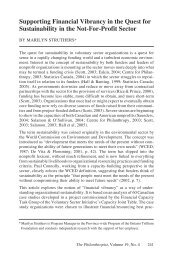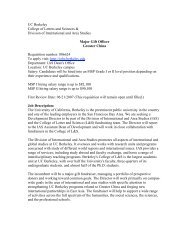Why Bad Presentations Happen to Good Causes - The Goodman ...
Why Bad Presentations Happen to Good Causes - The Goodman ...
Why Bad Presentations Happen to Good Causes - The Goodman ...
You also want an ePaper? Increase the reach of your titles
YUMPU automatically turns print PDFs into web optimized ePapers that Google loves.
pg. 28<br />
See Checklists <strong>to</strong> Go<br />
for a detachable<br />
summary of this section.<br />
Building Better <strong>Presentations</strong><br />
How <strong>to</strong> Take Your Audience from A <strong>to</strong> B – cont’d<br />
audience gets a carefully tailored message – and they work … that is, until the title character<br />
goes decidedly off-message. “Most people’s response <strong>to</strong> the video is overwhelmingly<br />
positive,” reports Ward. “What almost everyone says is that it got them <strong>to</strong> think about<br />
messaging in a different way.”<br />
Joel Bradshaw takes his audiences through a similar exercise by showing excerpts from<br />
“<strong>The</strong> Music Man,” and I begin my s<strong>to</strong>rytelling workshop by telling “<strong>The</strong> Wizard of Oz”<br />
s<strong>to</strong>ry, only I use the jargon-heavy language favored by most public interest professionals.<br />
<strong>The</strong> possibilities for context shifting are endless, and I encourage you <strong>to</strong> explore them.<br />
Those audience members staring at you with crossed arms and furrowed brows will<br />
thank you.<br />
Tell s<strong>to</strong>ries<br />
<strong>The</strong>re’s a maxim in public speaking that holds true whether you are addressing five<br />
people or 500: In a two-hour speech, people will remember a two-minute s<strong>to</strong>ry. Millennia of<br />
conditioning may have something <strong>to</strong> do with it. As a species, we evolved in s<strong>to</strong>rytelling<br />
cultures: That’s how each clan preserved its most important lessons and ensured they<br />
would be passed on <strong>to</strong> succeeding generations. Even <strong>to</strong>day, we read s<strong>to</strong>ries <strong>to</strong> our children<br />
beginning at very early ages, implicitly teaching them <strong>to</strong> look for the narrative structure<br />
that can bring order and meaning <strong>to</strong> a seemingly random jumble of events (otherwise<br />
known as “life”).<br />
In previous sections, several expert commenta<strong>to</strong>rs have already testified <strong>to</strong> their reliance<br />
on s<strong>to</strong>ries, and all 20 <strong>to</strong>ld us they routinely incorporate s<strong>to</strong>ries in<strong>to</strong> their speeches<br />
and workshops. Like learning styles, though, s<strong>to</strong>rytelling is a subject worthy of entire<br />
books – I have written one myself – so we do not intend <strong>to</strong> offer a comprehensive treatise<br />
here. Instead, let me suggest some questions that can help you sharpen the s<strong>to</strong>ries<br />
you want <strong>to</strong> tell:<br />
1. Who’s the protagonist?<br />
Just as a car needs a driver <strong>to</strong> get it where it’s going, s<strong>to</strong>ries need someone <strong>to</strong> drive the<br />
action. This person (or group of people) is called the protagonist, and traditionally<br />
structured s<strong>to</strong>ries follow protagonists in pursuit of clearly defined goals. To help your<br />
audience identify with the protagonist and enter the world of your s<strong>to</strong>ry, don’t be<br />
afraid <strong>to</strong> name names (when appropriate) and provide enough physical description or<br />
background <strong>to</strong> let them see this individual in their mind’s eye.<br />
2. What’s the hook?<br />
Another technique for drawing people in is beginning the s<strong>to</strong>ry where the audience is.<br />
This is your s<strong>to</strong>ry’s “hook” – the description of a place, circumstance, or premise that<br />
everyone understands and with which they readily identify. If the subject of your s<strong>to</strong>ry<br />
is global warming, for example, starting with facts about concentrations of carbon<br />
dioxide in the atmosphere is not going <strong>to</strong> engage the average person. On the other<br />
hand, asking, “Have you noticed that hurricanes keep getting stronger?” is more likely<br />
<strong>to</strong> get heads nodding.













